

Putting Two and Two Together. Coordinate Challenge. Lost. Cops and Robbers. 100 Percent. Dividing Fractions. Turn the second fraction upside down, then multiply.
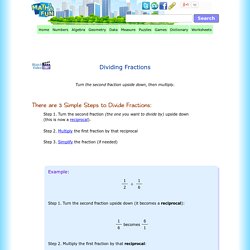
There are 3 Simple Steps to Divide Fractions: Example: Step 1. Turn the second fraction upside down (it becomes a reciprocal): Step 2. Algebra Quiz. Multiples, Factors, Prime, Square and Triangle Numbers wipeouts. Can You Decide? Topics: Starter | Number How did you use this starter?
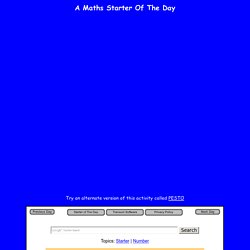
Can you suggest how teachers could present or develop this resource? Do you have any comments? It is always useful to receive feedback and helps make this free resource even more useful for Maths teachers anywhere in the world.Click here to enter your comments. If you don't have the time to provide feedback we'd really appreciate it if you could give this page a score! Excellent, I would like to see more like this Good, achieved the results I required Satisfactory Didn't really capture the interest of the students Not for me! This starter has scored a mean of 3.4 out of 5 based on 17 votes. First Connect Three. In this game the winner is the first to complete a row of three, either horizontally, vertically or diagonally.
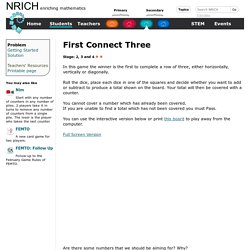
Roll the dice, place each dice in one of the squares and decide whether you want to add or subtract to produce a total shown on the board. Your total will then be covered with a counter. You cannot cover a number which has already been covered. If you are unable to find a total which has not been covered you must Pass. You can use the interactive version below or print this board to play away from the computer. Full Screen Version Are there some numbers that we should be aiming for? Tug Harder! You might like to try Tug of War before trying this.
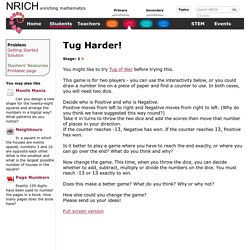
This game is for two players - you can use the interactivity below, or you could draw a number line on a piece of paper and find a counter to use. In both cases, you will need two dice. Decide who is Positive and who is Negative. Positive moves from left to right and Negative moves from right to left. (Why do you think we have suggested this way round?) Multiplying Negatives Makes A Positive. When We Multiply: Yes indeed, two negatives make a positive, and we will explain why, with examples!

Signs Let's talk about signs. "+" is the positive sign, "−" is the negative sign. Estimating Angles. Letters and Properties. Fraction and Percentage Card Game. KS3 Percentages. Matching Fractions Decimals Percentages. Matching Fractions. You may also like Chocolate There are three tables in a room with blocks of chocolate on each.

Basic Division 4. The Remainders Game. Factors and Multiples Game. This is a game for two players.
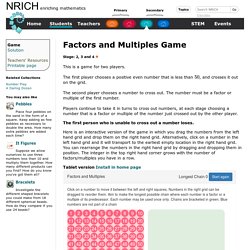
The first player chooses a positive even number that is less than , and crosses it out on the grid. The second player chooses a number to cross out. The number must be a factor or multiple of the first number. Players continue to take it in turns to cross out numbers, at each stage choosing a number that is a factor or multiple of the number just crossed out by the other player. The first person who is unable to cross out a number loses. Here is an interactive version of the game in which you drag the numbers from the left hand grid and drop them on the right hand grid. Tablet version Install in home page Flash Version Alternatively, you can print out some 1-100 square grids. Printable NRICH Roadshow resources: Instructions + Grid in 2 parts here and here.
An extension to the game, or a suitable activity for just one person, is suggested in the Possible extension in the Teachers' Notes. Sequences. Find the correct number in a sequence.

Lots of choice over level, count forwards or back, count in whole numbers, multiples of 10, multiples of 100, decimals and fractions. For more addition and subtraction resources click here. For more resources involving fractions and decimals click here. Fibonacci sequence. Coded Hundred Square. Rounding Spaceships - rounding to the nearest 10. Rounding Sharks - Round to the Nearest Hundred. Value of Digits. Parallel and Perpendicular Lines Game. Shape and Space Activities.
Symmetry A good tutorial with audio to help pupils learn the names of different polygons and how to draw lines of symmetry on some of them.
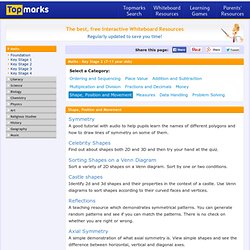
Celebrity Shapes Find out about shapes both 2D and 3D and then try your hand at the quiz. Sorting Shapes on a Venn Diagram Sort a variety of 2D shapes on a Venn diagram. Castle shapes Identify 2d and 3d shapes and their properties in the context of a castle. Reflections A teaching resource which demonstrates symmetrical patterns. KS2 Bitesize Maths - Shape, space & measures. KS2 Bitesize Maths - Symmetry : Play. 3-D Shapes. Maths interactive shape games. Rotational Symmetry Webquest - A Little Online Homework Help - Visual Math Learning for all Ages:) Groups2and3 4th February. Programme 18: Learn Your LinesRecognising properties of parallel and perpendicular lines Sad Man and the animals are making words out of straws.
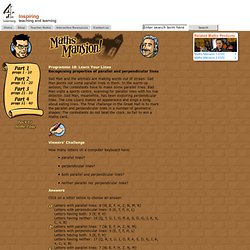
Sad Man points out some parallel lines in them. In the warm-up session, the contestants have to make some parallel lines. Bad Man visits a sports centre, scanning for parallel lines with his line detector. Sad Man, meanwhile, has been exploring perpendicular lines. Viewers' Challenge. Parallel Lines. Parallel and Perpendicular Lines. Perpendicular It just means at right angles (90°) to. The red line is perpendicular to the blue line in both these cases: (The little box drawn in the corner, means "at right angles", so we didn't really need to also show that it was 90°, but we just wanted to!)
Try for yourself (move points "A", "B" or "N"): Parallel Lines are parallel if they are always the same distance apart (called "equidistant"), and will never meet. Always the same distance apart and never touching. 6P Maths Group 3 - Volume of Prisms. 3D Shapes - Nets. Measuring and Time - Activities (JP Group) 6P Group - Units of Time. nRich Challenge - Capacity. A group of eight children in Class 6 were measuring water using measuring cylinders. They coloured the water to make reading the scales easier. They lined up the cylinders in two neat rows, each labelled with a child's name and the amount they had measured out.
Then Harry opened the window and the wind blew most of the labels onto the floor! "Oh! Harry! " KS2 Bitesize Maths - Measures : Play. MeasuringCylinder_1_2. Matching Fractions nRich Game. nRich Percentage Challenge! Matching Fractions Decimals Percentages. Converting Fractions to Decimals Game. Percentages Game.